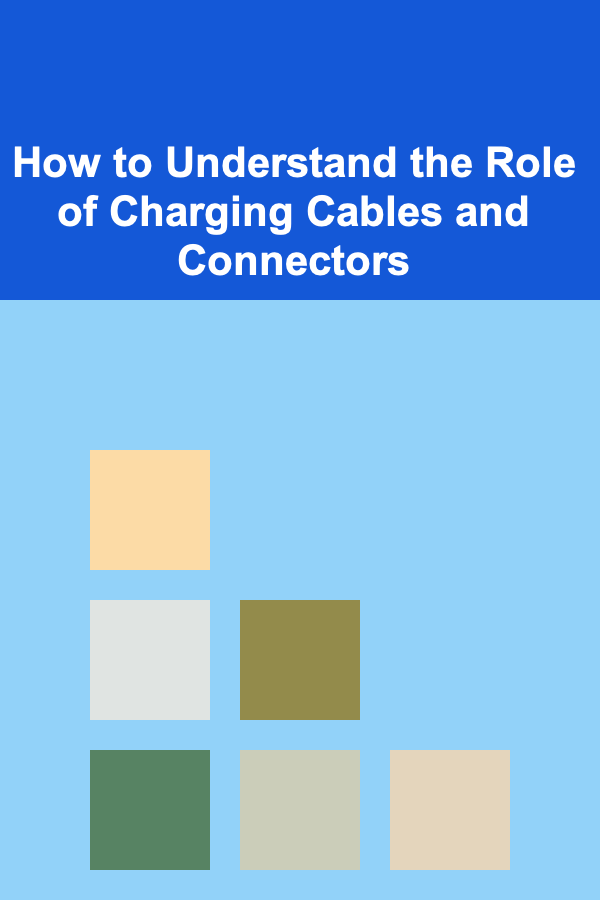
How to Understand the Role of Charging Cables and Connectors
ebook include PDF & Audio bundle (Micro Guide)
$12.99$11.99
Limited Time Offer! Order within the next:

In today's world, electronic devices are integral parts of daily life. From smartphones and laptops to electric cars and portable power banks, the demand for power is ever-increasing. One of the most crucial components enabling the flow of energy to these devices is the charging cable and connector. Understanding the role of charging cables and connectors is vital for ensuring efficient charging, device longevity, and overall satisfaction with the technology we use.
Charging cables and connectors are not just simple accessories; they are intricate elements that dictate how power flows from the power source to the device. This article will delve into the critical functions, types, components, and considerations surrounding charging cables and connectors. By the end of it, you will have a comprehensive understanding of their significance and how they impact the performance of your devices.
The Importance of Charging Cables and Connectors
At first glance, charging cables and connectors might seem like simple, unassuming accessories. However, their role goes much deeper than just connecting a power source to a device. They are the conduits through which energy flows, making them vital for the performance and longevity of electronic devices.
Power Transmission
The most fundamental role of charging cables and connectors is to facilitate power transmission. A cable's primary function is to transfer electrical energy from a power source (like a charger or power bank) to a device (like a phone, tablet, or laptop). The connector is the part of the cable that plugs into the device, completing the circuit and allowing energy to flow.
Speed of Charging
Charging cables also determine how quickly a device charges. Different cables support different charging speeds, depending on their specifications. For instance, cables designed for higher currents or those supporting fast-charging technologies can significantly reduce the time it takes to fully charge a device.
Device Protection
An often overlooked but equally important function of charging cables is device protection. Poor quality or damaged cables can lead to overheating, short-circuiting, or, in the worst cases, damaging the device or the power source. High-quality cables with proper insulation, shielding, and durable connectors help ensure safe charging and prevent any electrical hazards.
Durability and Longevity
The design and quality of charging cables and connectors also affect their durability and lifespan. With frequent use, cables are subjected to wear and tear, such as bending, twisting, and friction. Cables that are poorly constructed or made from subpar materials can degrade quickly, affecting their performance. On the other hand, well-designed cables and connectors can last for years if properly cared for.
Types of Charging Cables
Charging cables are not a one-size-fits-all solution. There are various types of charging cables designed for different devices and charging standards. Each type has its own specifications and functionalities, catering to specific needs.
USB-A to USB-B Cables
The USB-A to USB-B cable is one of the oldest and most commonly used types of charging cables. The USB-A connector is typically found on the charger or power source, while the USB-B connector is often used in devices such as printers, scanners, and some older external hard drives.
- USB-A: The standard rectangular connector commonly used in computer peripherals.
- USB-B: The square-shaped connector used for larger devices, such as printers.
Although not as popular in modern mobile devices, USB-A to USB-B cables are still in use in various industrial and office equipment.
USB-A to USB-C Cables
USB-C is the next evolution in the USB standard and is quickly replacing older USB-A cables. USB-A to USB-C cables are used to connect devices with a USB-C port (such as smartphones, laptops, and other modern electronics) to older charging sources or computers that still use USB-A ports.
- USB-C: The modern, oval-shaped connector that is reversible and supports higher data transfer speeds and power delivery.
This type of cable is commonly used to charge devices such as smartphones, laptops, and tablets.
USB-C to USB-C Cables
The USB-C to USB-C cable is the future of charging and data transfer. With the widespread adoption of USB-C across various devices (such as modern smartphones, laptops, tablets, and chargers), these cables are becoming the standard. USB-C supports fast-charging capabilities, higher data transfer speeds, and better power delivery than its predecessors.
- USB-C to USB-C: Both ends of the cable use USB-C connectors. This is particularly useful for charging devices like laptops that support USB-C charging and data transfer.
This type of cable is essential for modern tech users, offering versatility and speed.
Lightning Cables
Apple's proprietary charging cable, the Lightning cable, is used exclusively with Apple devices such as iPhones, iPads, and iPods. While it is not universally compatible with non-Apple devices, it remains a staple in the Apple ecosystem.
- Lightning Connector: A compact and reversible connector used in Apple devices for both charging and data transfer.
While USB-C is gaining traction, Apple has continued to use the Lightning cable in many of its products, particularly in iPhones.
Micro-USB Cables
Before the rise of USB-C and Lightning, micro-USB was the most common charging cable for smartphones, tablets, and other electronic devices. Although USB-C has mostly replaced micro-USB, it is still used in some devices, especially in older models or budget devices.
- Micro-USB Connector: A smaller version of the USB-A connector that is often used in older smartphones, tablets, and various other portable electronics.
Despite its diminishing presence in modern devices, micro-USB cables are still commonly found in various electronic accessories and devices.
Magnetic Charging Cables
Magnetic charging cables offer convenience and ease of use, especially for users who want to quickly plug in their devices. These cables use a magnet in the connector that attaches to a corresponding magnetic port on the device. Magnetic charging cables are often found in wireless charging systems, where ease of connection is a priority.
- Magnetic Connectors: They use magnets to attach to the charging port, allowing for a secure and easy connection without having to worry about orientation.
Magnetic charging cables are popular in wireless earphones, smartwatches, and portable power banks.
Charging Connectors and Standards
Charging cables are only as effective as the connectors they are paired with. The connector is the part of the cable that plugs into the device, and its role is critical in determining the efficiency, speed, and safety of the charging process.
USB Connectors
- USB-A: The standard rectangular connector commonly used in older computers and power adapters.
- USB-B: The square connector used primarily in printers and larger devices.
- USB-C: The modern, versatile connector that supports fast charging, high data transfer speeds, and reversible connections.
- Micro-USB: The older, smaller connector used in older smartphones and devices.
- Lightning: Apple's proprietary connector used in iPhones and other Apple devices.
Charging Standards
There are several charging standards that influence how effectively power is transmitted through cables and connectors. These include:
- USB Power Delivery (PD): A fast-charging standard that allows higher power transfer through USB-C connections. USB PD supports charging speeds up to 100W, which is ideal for larger devices like laptops.
- Qualcomm Quick Charge: A proprietary fast-charging technology developed by Qualcomm that allows devices to charge more quickly by increasing voltage.
- Wireless Charging (Qi): A wireless charging standard that uses electromagnetic fields to transfer energy between a charging pad and a device, eliminating the need for physical cables.
How to Choose the Right Charging Cable and Connector
Selecting the correct charging cable and connector depends on several factors, including device compatibility, charging speed, and cable durability. Here are some important considerations when choosing the right charging cable:
Compatibility
Ensure that the charging cable and connector are compatible with both your device and the power source. For example, if you're charging an iPhone, you'll need a Lightning cable, whereas a USB-C cable would be necessary for newer Android phones or laptops.
Charging Speed
If fast charging is a priority, choose a cable that supports the appropriate fast-charging standard, such as USB Power Delivery or Qualcomm Quick Charge. Be sure to check if both the charger and the device support these technologies.
Durability
Look for high-quality cables with reinforced connectors and durable insulation. Braided cables tend to last longer and resist tangling compared to traditional rubber cables. Additionally, cables with reinforced connectors can withstand frequent plugging and unplugging without wearing out.
Cable Length
Consider the length of the cable based on your charging setup. A longer cable might be more convenient for charging devices from a distance, but it can also result in slower charging speeds due to voltage drop. A shorter cable is ideal for faster charging speeds, but it may limit flexibility in certain setups.
Conclusion
Charging cables and connectors play an essential role in our daily interactions with electronic devices. From ensuring power transmission and safe charging to affecting the speed and performance of our gadgets, these components are critical to the overall user experience. Understanding the different types, standards, and factors to consider when selecting charging cables and connectors can significantly improve the efficiency of your charging setup and extend the life of your devices.
As technology continues to evolve, the importance of high-quality cables and connectors will only increase. Whether you're a casual user or a tech enthusiast, having a solid understanding of these components will ensure that your devices are charged quickly, safely, and efficiently.

How to Save Space in a Studio Apartment with Clever Layouts
Read More
How to Set Up Your Airbnb Listing to Attract More Guests
Read More
How to Start a Family Book Club with Engaging Reads
Read More
How to Update Your Home's Curb Appeal with a Small Budget
Read More
How to Update Your Home's Lighting Without a Full Renovation
Read More
Analyzing Starlight: Unveiling the Secrets of the Cosmos
Read MoreOther Products

How to Save Space in a Studio Apartment with Clever Layouts
Read More
How to Set Up Your Airbnb Listing to Attract More Guests
Read More
How to Start a Family Book Club with Engaging Reads
Read More
How to Update Your Home's Curb Appeal with a Small Budget
Read More
How to Update Your Home's Lighting Without a Full Renovation
Read More